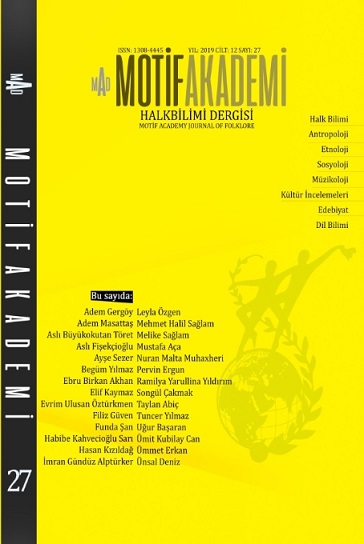ÖLÜ/ÖLÜM ETRAFINDA GELİŞEN KÜLT İNANÇLAR VE GRUBUN YENİDEN BÜTÜNLEŞMESİ (SİNOP LALA KÖYÜ ÖRNEĞİ)
THE CULTIC BELIFS THAT ARE FORMED AROUND THE DEAD/DEATH AND THE REINTEGRATION OF THE GROUP (THE EXAMPLE OF LALA VILLAGE IN SINOP)
Author(s): Filiz GüvenSubject(s): Cultural history, Customs / Folklore, Ethnohistory, Sociology of Culture
Published by: Motif Halk Oyunları Eğitim ve Öğretim Vakfı
Keywords: The dead/death; transitional periods; ritual; separation ceremonies; cultic beliefs;
Summary/Abstract: The death, which is the last basic incident of life in all over the world and all religions, stands at the core of the life as biological, sociological, anthropological, psychological fact. In this regard, the separation ceremonies are within the important phases of life in almost every society regardless of time and place and they are supported by some rituals that take their origins from tradition. Whereas the societies might have different attitudes towards the death, all of those societies’ common sense is deprivation. Various ceremonial practices and beliefs that are based on archaic times and that can be counted as cultic are evolved around the sense of deprivation towards a husband/wife, a friend or a relative. These practices form the connective side of the society/ group by sustaining emotional union to the individual with different religious/spiritual rituals. This research aims to identify the cultic beliefs preserving their nature in the sense of death, from the viewpoint that the practices in the sense of death/the dead are the connective sides of the society/ group in the village of Lala in Sinop, with Georgian people. The obtained findings in this context will be for clarifying the reflections of the sacred and cultural values of the people from archaic period on today’s world and the connective side of the social practices ongoing in this context.
Journal: Motif Akademi Halkbilimi Dergisi
- Issue Year: 12/2019
- Issue No: 27
- Page Range: 539-552
- Page Count: 14
- Language: Turkish

